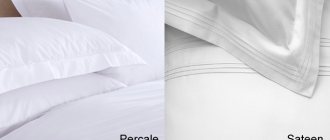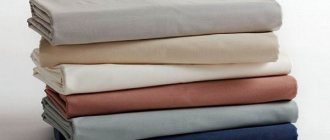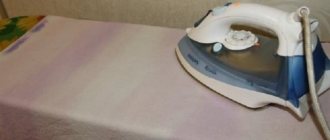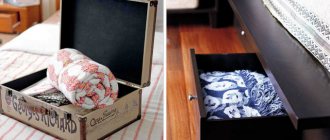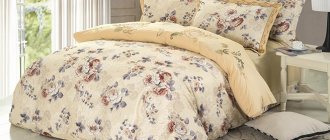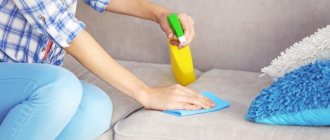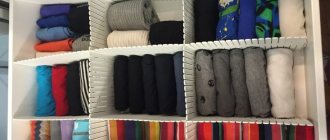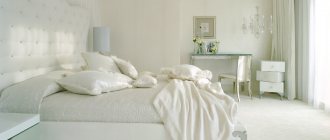Before we begin considering the best fabrics for bed linen, pay your attention to a store that provides the opportunity to buy any bed linen in Moscow and Russia:
We recommend the Sovinson.ru store for choosing and purchasing bed linen for your home.
As modern research shows, the quality of sleep is influenced not only by the microclimate of the room, but also by properly selected bedding. Lingerie manufacturers use various fabrics to sew them. We invite you to consider the best fabrics for bed linen, outlining their advantages and disadvantages.
Polysatin
Strong, durable, versatile and budget-friendly fabric. Contains synthetic polyester fiber and satin-woven cotton threads. The texture of the fabric is durable, soft and silky.
Advantages: the fabric is wear-resistant, does not wrinkle, holds the 3-D print perfectly, retains its original shape and color depth, even after numerous washes.
Disadvantages: since the fabric is not natural, it can become electrified, have poor air permeability, form pills on the surface and even cause allergic reactions.
Quality of seams and threads
The service life of bed linen depends not only on the correct fabric. The quality of seams and threads plays an important role in this matter. Before purchasing, it is advisable to open the package and carefully inspect the seams.
Some should be double folded and stitched. A single seam or its absence indicates a violation of the requirements. After the first wash, such linen will become frayed and unusable.
The threads must be strong and match the color of the fabric. The absence of protruding ends is a prerequisite for quality bed linen.
Polycotton
A synthetic fabric created back in the 50s of the last century and containing cotton and polyester.
Advantages: the fabric has an affordable price, wear resistance, practicality, hygiene, ease of care, no need for ironing.
Disadvantages: poor air permeability, electrification, pellets after washing, can cause an allergic reaction to synthetic components.
Viscose is given 6th place in our ranking
This fabric occupies an intermediate position between natural and artificial fabrics. It is made from cellulose, so it’s hard to call this material “synthetic”. It is surprisingly soft and delicate to the touch, it has all the properties characteristic of natural fabrics. However, the process of obtaining it cannot be called the most environmentally friendly in nature.
Sleeping on viscose bedding is a pleasure, but do not forget that it is negatively affected by ultraviolet rays and high humidity.
Advantages:
- Capable of absorbing large amounts of moisture;
- Allows the surface to “breathe”;
- Does not accumulate static electricity;
- Affordable price;
- Wide range of colors;
- Maintains fresh color for a long time;
- Despite the fact that it belongs to artificial fabrics, it has “natural” characteristics.
Flaws:
- Wrinkles a lot;
- It wears out with prolonged use;
- Requires special care;
- Not a completely safe manufacturing process.
Flannel
The fabric is divided into three types: cotton, wool and wool blend. It has double-sided and single-sided sparse pile, which gives the fabric softness and comfort.
Advantages: the fabric perfectly retains heat, absorbs moisture, retains color and shape after washing.
Disadvantages: takes a long time to dry, forms pellets with prolonged use.
Calico
Natural cotton fabric with plain weave.
Advantages: the fabric allows air to pass through freely, has excellent hygienic properties, is durable, wear-resistant, and easy to care for.
Disadvantages: it is not soft enough according to some consumers.
Ranfors
An improved version of calico fabric. The increased number of fibers is one and a half times higher than the density of ranphos compared to calico, which significantly affects its service life. Additional cleaning of the fibers and their cross-shaped weaving give the fabric smoothness, softness and silkiness.
Advantages: does not fade or shrink even after numerous washes.
Disadvantages: costs more than calico.
Tips for choosing: what to look for
On the Internet you can often find advice that you need to look at the neatness of the seams, uniform color and good smell. But these things will catch your eye anyway, but here's what many people really miss:
- If your blanket is not white, but bright and with a colorful pattern, then when choosing light and snow-white linen, pay special attention to the density of the fabric, check it for light. Otherwise, there is a risk that the pattern of the red-orange desert with a camel will casually show through the linen and look cheap and untidy.
- Don't try to compromise on size. Even if you really liked the underwear, but don’t have the right size, refuse to buy it. You will be tired of folding the extra 20-30 cm of the duvet cover every time, or, conversely, searching for the blanket in the depths of the fabric. A beautiful set will hang on the shelf like dead weight.
- For a mattress of a non-standard size, you need to measure all its parameters, add height and order a sheet 20 cm larger in width and length than your sleeping place. There are special sheets for round/oval mattresses, but if you can’t find them, then buy a classic, straight model without elastic that is twice the size of the sleeping area.
- Lingerie as a gift is a good idea, because we use it every day, but only for a close circle. You should know exactly not only the size of the mattress, blanket and pillow, but also people's preferences: some like to sleep on high square pillows, while others sleep with their partner under different blankets. It’s better to check the dimensions, and if you want to make a surprise, you can find out the necessary parameters carefully. For example, when visiting, praise the linen and ask about the sizes. Today, almost all brands package sets in beautiful gift boxes.
- Pay attention to the package. The family size usually comes with two duvet covers, and the euro size usually comes with four pillowcases.
- Think about clasps in advance. You'll be taking the item on and off many times, so it's important to understand which clasps work best for you. Duvet covers and pillowcases can have ties, buttons or a hidden zipper. There are also pillowcases with a flap - this is when on one inner side there is a reserve of fabric that securely holds the pillow inside the pillowcase.
- Type of sheet. A classic straight sheet fits any mattress and can hang beautifully on the floor if desired. And the model with an elastic band is attached around the entire perimeter or only in the corners to the mattress and does not get knocked down even during active lovemaking or restless sleep. Some sets do not include a sheet.
- The finish should be smooth. Embroidery or print is a good option for decorating bed linen, but it is better to leave braid, buttons and beads for the bedspread, otherwise there is a risk of catching your hair, scratching your skin and getting minor but unpleasant injuries in your sleep.
Atlas
Silk and semi-silk fibers contained in the fabric give it a smooth, silky, luxurious and rich appearance.
Benefits: The fabric is durable, wear-resistant, breathable, temperature-controlled, wrinkle-resistant and incredibly soft.
Disadvantages: expensive, washable only on delicate cycle or by hand.
Dimensions
Inconsistency in the size of bedding items leads to discomfort during sleep. If the bed linen is smaller than the size of the pillow, blanket or mattress, then folds and creases will form, causing a lot of inconvenience. If the size is too large, it is easy to get tangled in the duvet cover or get your hand caught in the pillowcase. To simplify the selection of bed linen, special standards have been developed that all products included in the set must meet.
There are several types of bed linen:
- single,
- one and a half,
- double,
- eurostandard,
- family,
- children's,
- for newborns.
For each type, there are standard sizes of pillowcases, sheets and duvet covers.
Satin
Fabric made from natural cotton, made by double twisting of fibers. Popular among housewives due to its rich color range.
Advantages: smooth, silky, durable, perfectly breathable, does not wrinkle and does not cause allergic reactions.
Disadvantages: its price is higher than other cotton fabrics.
Silk
And finally, silk.
This is a luxurious fabric not only for clothing, but also for bedding. Smooth, shiny silk bed linen not only decorates the bed, but also treats rheumatic pain, and some skin diseases are cured much faster, since silk contains amino acids. The fabric is hypoallergenic, regulates body temperature, and does not lose color for a long time. Silk is a durable material that is easy to wash, has high hygroscopicity and disinfectant properties, and is therefore suitable for those with sensitive skin. Sleeping on a pillow with a silk pillowcase is good for your hair - your hair will also become silky and acquire a healthy and natural shine.
Exposure of silk to ultraviolet radiation is undesirable.
The most expensive bed linen is made from the highest grade Mulberry! But there is another type of silk - Tussah, which is cheaper. Its fibers are slightly coarser and shorter. Fabrics from Tussa are not so smooth and soft, but this is because the butterfly itself gnaws the cocoon and flies away, that is, continues its life, which cannot be said about silk with long fibers, which are obtained from cocoons by force. That is, Tussah silk is obtained almost naturally.
Silk is the most expensive fabric, because no other fabric can compare with its beauty. The disadvantage of silk can be considered special and delicate care. Many manufacturers recommend dry cleaning, but you can also use hand washing at a temperature not exceeding 30 °C, without rubbing, bleaching, twisting, but only lightly pressing with your hands. Dry all items flat, iron inside out, at low temperatures and without using steam. It is best to sleep on silk underwear in the summer.
Linen
One of the most natural fabrics presented in the rating.
Advantages: the fabric is environmentally friendly, temperature-controlled, gyroscopic and perfectly breathable. It has unique antiseptic properties and prevents the development of bacteria and microorganisms.
Disadvantages: it wrinkles easily, has a limited range of colors, and is more expensive than cotton fabrics.
Satin Lux
The fabric is made from two different fibers using satin weaving. Thanks to this, it has two sides: shiny and matte.
Advantages: the fabric is temperature-controlled, environmentally friendly, does not cause allergic reactions and perfectly retains its shape and color even after many washes.
Disadvantages: since the fabric belongs to the elite category, it is quite expensive.
Mako satin
The production technology is reminiscent of the production of luxury satin fabric, and its composition includes only first-class cotton.
Advantages: the fabric is not prone to wrinkle, become electrified, or cause an allergic reaction. Environmentally friendly. Does not deform after washing, dries quickly. It looks simply luxurious on the bed.
Disadvantages: none found.
Poplin deserves 2nd place
Poplin bed linen is loved by many, and this is no coincidence. It is incredibly pleasant and gentle. Falling asleep in his arms, you will feel comfort and relaxation. All the fatigue that has accumulated during the day will instantly go away, and you will plunge into a calm, serene sleep.
However, the name “poplin” does not indicate the composition of the fabric, but the method of weaving the fibers. Both natural and artificial fibers can be used as a base. However, more often the “natural” composition predominates.
Advantages:
- Soft and gentle to the touch;
- Easy care;
- Strength and durability;
- Practically does not wrinkle;
- Dries quickly;
- Suitable even for allergy sufferers;
- Safe material;
- Suitable for any time of year;
- Does not interfere with air circulation;
- Easy to paint;
- Acceptable price.
But it is worth noting one small drawback:
- May shrink when washed (up to 10%).
Comparing the advantages and disadvantages, we can say with confidence that poplin is a worthy fabric with excellent characteristics.
Satin stripe
High-quality all-natural cotton fabric from the elite category. It is produced using the technology of satin weave fibers, twisting them obliquely.
Advantages: practical, wear-resistant fabric with an impressive appearance.
Disadvantages: very expensive.
How to choose fabric for bed linen?
In the online catalog, before purchasing textiles, you should definitely look at the photos, which clearly show the texture of the fabric and its cut: pay attention to the fraying of the threads, the density and method of weaving the fibers, as this will create an understanding of how difficult the fabric is to sew and how practical it is to use. . If you buy fabric in a real store, and do not order online, you can check the quality of the fabric in the following ways.
✔️ Take a look at the degree of twisting of the thread. The tighter and tighter they are twisted, the less the fabric will fray during use. This is especially necessary when choosing cotton fabric for bed linen and material containing synthetics (polycotton, polysatin), since in the first case, the cotton fibers are very short and are more likely to form unwanted hairiness, and in the second, accumulated static electricity can lead to the formation of pellets .
✔️ The type of weave also plays an important role in the durability of the finished product. To determine the actual density, lift the edge of the fabric and check it for light. The less light a material transmits, the longer it will last. The lowest quality fabrics have virtually no visible interlacing of threads; they are permeable through and through. Ideally, the fabric should have subtle holes through which light passes, and the material itself should resemble paper more than burlap.
✔️ Smell a piece of plain-dyed or printed fabric. High-quality fabric should not smell of chemicals: often fabrics with synthetic admixtures have a sour smell, similar to vinegar. This directly indicates allergenicity and the use of toxic dyes.
✔️ Slightly crush the sample in your hand and hold for about half a minute. Then open your hand, remove the flap and touch your palm with your fingers: one should be dry. If your palm is sweaty, the material has a low ability to absorb moisture. This means that sleeping under bedding made of such fabric will be hot and wet, and this is bad for the health of the skin and nervous system.
Jacquard
The fabric is made using a special jacquard weaving. The weaving method allows you to add texture to the fabric and your own unique pattern. Jacquard linen will bring a touch of aristocracy to your bedroom.
Advantages: the fabric has a luxurious appearance, softness and silkiness.
Disadvantages: not everyone can afford it.
Percale
“Royal” fabric made in the best Irish traditions. Can be made from: linen, cotton, cotton base mixed with synthetic fiber. The special smoothness of the fabric is given by a unique manufacturing method - sizing, which literally glues the fibers together.
Advantages: the fabric is strong, durable, not prone to deformation, does not fade, has excellent air permeability, absorbs moisture, does not cause allergic reactions, and is moderately expensive.
Disadvantages: none found.
We hope our article will help you make your choice. Happy shopping and sweet dreams!
Which fabric is best for bed linen: a review of inexpensive options
Ranfors is the best fabric for bed linen
Ranfors is a type of poplin; it is a luxury version of textile fabric with an improved texture and increased wear resistance. It is soft and silky to the touch, but at the same time with a fairly high density of fiber weaving. A distinctive feature of the material is its production technology. The threads are slightly twisted (unlike the straight version in calico). Ranfors is the best fabric for bedding for a baby's crib, as it conducts heat well and does not harm the baby's skin. The material ventilates well, does not change color when washed, and also has good strength indicators.
Cotton is used to make ranfors, and cotton is grown mainly in Egypt. Due to its naturalness, the fabric is most often used for sewing bedroom sets and home textiles. Kitchen towels and tablecloths made from this material also have a number of advantages. Ranfors is suitable for sewing sleeping clothes. However, for sewing sleeping sets, it is not recommended to use linen with synthetic fibers in its composition, as it can pill, as evidenced by reviews from buyers of ranfors bed linen.
Another underrated property of ranfors is the ability to freely evaporate moisture, which is useful not only for quickly drying products, but also for skin breathing. During sleep, metabolism accelerates, and therefore the body begins to sweat more actively and remove salts along with moisture. Ranfors easily absorbs liquid and releases it into the air, and salts and dead cells that accumulate on the surface are easily rinsed out during washing, since the special weaving of ranfors prevents their penetration into the fibers.
Advantages:
- Pleasant to the touch
- Doesn't fade or fade
- No pellets are formed
- Relatively low cost (from $5.5)
Flaws:
- 3D prints are not applied to the material
- Not suitable for use in cold weather
- Does not have a matte or silky shine
See all colors
Cotton sateen - luxurious fabric for bed linen
Satin is one of the best fabrics for premium bedding. The material is natural, with a smooth and silky surface, which creates a tactile sensation of slight coolness. Satin manufacturing technology involves the use of the satin weaving method. This production method makes satin similar to natural silk, giving the surface a noble pearlescent shine and a soft texture. The prints on this fabric are distinguished by their brightness and richness of shades. Color fastness indicators are among the highest among other types of textiles in the average price range.
The operation of products made from satin fabric, as well as their care, is very simple, but it is very important to properly care for sleeping sets. For example, it is not recommended to dry satin in direct sunlight. Otherwise, the color may not fade, but will become less distinct. The fabric is hypoallergenic. Satin is the best fabric for bed linen, but at the same time it is widely used to create home textiles and underwear. Bedspreads and pajamas made from this material have good characteristics.
Pros:
- Long service life
- Color fastness
- High strength
- Hygiene
Minuses:
- Fairly high price (from 8 dollars)
- Need for careful care
- Not always suitable for winter
- In the summer, sleeping with such bedding can be hot
See all colors
